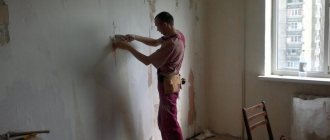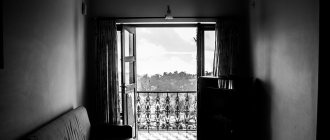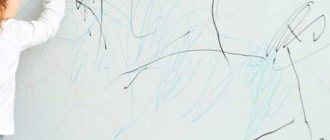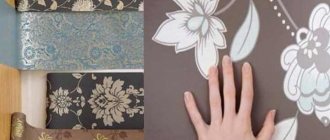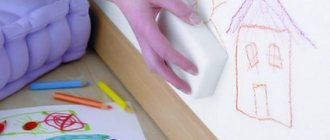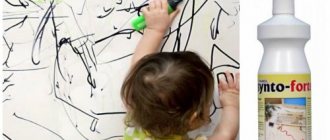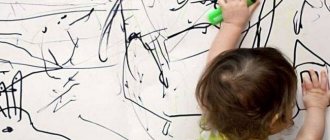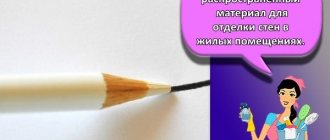Markings on wallpaper: what do these letters and symbols mean? When choosing new wallpaper for your home, you need to pay attention to the markings on the roll packaging. On it we can find a huge number of different emblems and symbols. And this is not just a collection of meaningless drawings and letters. Each individual symbol has its own meaning and carries certain information. So, let's try to figure it out. All designations on the wallpaper can be divided into the following groups:
- by composition;
- according to gluing features;
- by light fastness;
- moisture resistance;
- according to the features of dismantling.
How to correctly combine patterns on wallpaper?
First, we cut off the first strip of wallpaper from the beginning of the roll, and then unwind the second roll of wallpaper and select the pattern, matching the canvas until the pattern matches. After you have prepared several strips, you can start gluing the wallpaper.
Interesting materials:
What is the green card lottery? How many days off are there May holidays this year? How to fry butter, how long? Ibp what is this in accounting? How to eat honeycombs? How long can Melaxen be taken? Melatonin what is it? What benefits does Meldonium give to an athlete? Microsoft visual c what is it? How long should I take Mildronate before training?
Why even experienced craftsmen manage to glue wallpaper upside down
Wallpaper patterns don't always tell you where up and down are, as is the case with characters, animals, people, or buildings. It is more difficult to understand how wallpaper from a roll with abstract images, ornaments or even flowers should be glued. Anyone can make a mistake, including experienced professionals.
A common reason is that the manufacturer incorrectly wound the wallpaper onto the roll, or did not make markings indicating the top and bottom. When purchasing, this important factor should be checked to make the task easier and avoid mistakes. One’s own inattention as a human factor also plays an important role. It’s not so difficult to make a mistake, especially if you glue the wallpaper alone.
The markings on the wallpaper are presented as an insert for the roll and have many symbols, the main ones of which are hints in determining the top and bottom of the pattern:
- arrows located towards each other - direct arrangement of the picture;
- offset arrows - offset location of the picture;
- arrow pointing to a circle - any location of the picture;
- one arrow - wallpaper is glued from top to bottom;
- parallel arrangement of arrows, but in different directions - wallpaper is glued from bottom to top.
In addition to the direction of the pattern on the wallpaper, markings can provide information about the quality of the material. How waterproof are they, are they susceptible to color loss due to ultraviolet rays, are they susceptible to wet cleaning or not, and how quickly do they ignite.
Instructions for the wallpaper are included with the roll and have letter and graphic designations. The first ones determine the type of wallpaper (paper, acrylic, textile, structural for painting, embossed and flat vinyl, glass wallpaper).
The correct sequence of pasting the canvases:
First, cut one sheet of wallpaper to the height of the wall. Afterwards, we focus on the first sheet, and cut off the next sheet so that it matches the pattern with the previous one, taking into account the marking data. Be sure to glue the wallpaper in a circle so that the pattern matches on each sheet.
Tip: in the absence of a marking insert, you can determine the location of the pattern by eye. Each cut piece must be marked on the reverse side with a pencil. If the top is difficult to determine from the drawing, then the first free end when unrolling the roll can be considered the initial one.
At least two craftsmen must be involved in wallpapering in order to avoid mistakes and complete the job efficiently.
What is wallpaper rapport and what does it affect?
Budget-friendly renovations often include the use of wallpaper. However, in order to understand how much wallpaper you need, you must first conduct a proper accounting of the material. And here the question arises: what is wallpaper rapport in itself, what does it give as a concept? This is a repetition of a certain pattern on a sheet of wallpaper. There is a distinction between lateral rapport and the one that goes along the height. The latter is repeated repeatedly along the height of the sheet itself, and the side - along the width. But this directly depends on the specific size and type of the drawing itself. Having information about what wallpaper rapport is in practice, you can imagine how it will look specifically on your walls, and you don’t even have to use a piece of paper for this. You can simply visualize the result by calculating the scale, angle of incidence of light or its refraction.
This information can be found directly on the wallpaper rolls; rapport data is available when purchasing a particular model. With this information, you can make an informed decision about whether to purchase a particular version or not. Modern versions are specially packaged in film, under which you can always find a sheet of markings with exact symbols and numbers. And if you understand them, then this is a real chance to avoid a wrong choice. Some symbols show how long the wallpaper is guaranteed to serve you and how resistant it is to light. Others allow you to understand in what order you should paste the wallpaper and what overlay is allowed.
The influence of rapport on the finished result
The word rapport itself is derived from a similar French word, where it denotes a relationship or connection. In the case of wallpaper, we mean the ratio of the number and arrangement of sheets on the wall to each other. Please note: the arrows on the left and right indicate exactly how the panels should be positioned in relation to each other. If the roll has an arrow and a zero in combination, then such signs indicate that any combination is acceptable, that the design here allows you to play with the material itself as much as possible. However, this happens quite rarely. If you are not sure that you will understand the markings correctly or understand the markings, then you should seek advice. Marking makes it possible to understand how many exact sentiments need to be shifted and where exactly the canvas should be in order for the pattern to connect as it should.
Also, based on this indicator, you can draw conclusions about how much waste you will have. The longer the rapport itself, the more there will be. Therefore, take into account the need to take into account a reserve when purchasing. Wallpaper rapport as the distance between individual elements of the entire picture should also be taken into account by those who have small children or animals at home, that is, those who can threaten the background in your case. Taking this indicator into account, you need to make purchasing decisions.
Rapport of wallpaper and some design flaws
Wallpaper rapport may be shifted. This means that there is not exactly the same distance between the drawing of the first and second column, the second and third, and so on. Please note that recently diagonal pattern options have become extremely popular; calculations here are somewhat more difficult. But in general, the procedure is not as scary as it might seem. The absence of such an indicator as rapport may mean that we are talking entirely about plain wallpaper, for example, for painting, that this is a fake, for which they forgot to indicate such an important fact. Or that the pattern is too small and evenly scattered across the entire field, although in this case such indicators are taken into account.
vote
Article rating
Resistant to washing. Wallpaper care
Wash-resistant wallpaper is a must-have in the kitchen and hallway. On the wallpaper, this data is indicated by pictograms with wavy lines:
- A single wavy line indicates that the wallpaper is not resistant to water. They are moisture resistant only at the time of gluing. Glue stains can be carefully removed with a rag.
- Two lines – the wallpaper is moisture resistant and can be wiped with a damp sponge
- Three lines – wash resistance. Such wallpaper will withstand washing with a sponge and a mild detergent.
- The fourth position - with a wavy line and a brush pattern classifies the wallpaper as wear-resistant. They can be washed with a brush and a mild detergent, but the washing should be gentle.
- Fifth position - three wavy lines and a brush - the wallpaper is resistant to friction - resistant to friction with a brush and the aggressive effects of detergents.
Glue wallpaper with a repeat of 64 cm
Good evening. I just can’t understand why they make such wallpaper - the length is 10.05 m, the repeat is 64 cm. The length of the roll is not a multiple of the repeating pattern. Ceiling height 2.5 m, nearest multiple of 64 cm strip length 2.56 m. 10.05/2.56=3.9 pcs. what the hell. Why do I need 3.9 lanes? As a result, the fourth strip is 2.37 m long for ejection. Out of four rolls you throw away one. Anyone who understands this, please explain.
09/14/2014 at 21:20
What exactly? Why do they produce wallpaper like this? Because they turn out beautiful and make money. For everything, there will always be a buyer. Well, the height of the rooms is different.
09/14/2014 at 21:54
It’s just that the saleswoman in the store tried to explain to me that you can still squeeze 4 strips out of a roll if you cut from different rolls. But I still didn’t understand the logic. There is only one thing in my head - if you want to save the drawing, cut only in multiples of the length of the drawing, i.e. 2.56. And 10.05 is not divisible by 2.56, even if you cut it from 10 rolls, you can’t fool the arithmetic.
09/14/2014 at 22:32
commax wrote: you can still squeeze 4 strips out of a roll if you cut from different rolls. But I still didn’t understand the logic.
The logic is that first we glue the rest. Then we dock another piece from below.. Of course we select a pattern and glue it with an overlap. Then both canvases are cut, the scraps are thrown out and it looks like one canvas. It’s a hassle, but you can save money. Determine in advance the places for such “inserts”. As a rule, behind cabinets, etc.
Dismantling of canvases.
Why is it important? Not for the next renovation, of course, although... There are situations when we know that we will have to remove the wallpaper after gluing it. For example, in a new house, cracks may appear in the putty when the house shrinks - this is a completely normal situation. In such cases, the canvas is peeled off, the cracks are rubbed out and re-gluing is performed.
- Completely removable . During dismantling, they are completely removed from the wall.
- Partially deleted . The top layer is removed immediately, but the second layer remains on the wall; to dismantle it you need water and a scraper or spatula.
- Removal using tool . The wallpaper is removed in one layer using a scraper.
Preparing the wall surface
Surfaces are prepared in the same way as for other work.
- The walls are cleared of old wallpaper.
- They are primed.
- If there are cracks, unevenness or chips, then it is worth filling these defects.
- The wall should dry well.
- Places where the plaster layer is applied must be sanded with a sanding mesh or sandpaper.
- The surface of the walls is primed again.
Light fastness. Resistant to fading
If your windows face south, you understand perfectly well what we are talking about. Constant sun shining through the windows, especially in summer, can make the brightest and richest shades of the finish fade in one season.
- Medium light fastness - this wallpaper is recommended for rooms with low penetration of sunlight, for example, on the north side
- Satisfactory resistance to sunlight. This sign adds durability to the material, which means that the wallpaper is already more resistant to direct sunlight, but over time it fades
- Good light fastness - wallpaper does not fade in sunlight
- Very good light fastness - wallpaper will not fade under prolonged exposure to direct sunlight
- Excellent sun resistance . Wallpaper of this type will withstand even constant exposure to direct sunlight.
Pasting wallpaper with a pattern in the corner
Often, when gluing trellises, a situation occurs when the picture is distorted in the corner, then you cannot do without combining it with a strip.
To prevent this, you need to:
- leave an overlap of wallpaper on the adjacent wall;
- mask the formed joint at the top of the corner;
- Glue the edges of the strips clearly along the pre-drawn line. The end of the second strip is cut in the corner.
Wallpaper with a pattern is much more difficult to apply than plain wallpaper. If you know some of the subtleties of the work, you can not only simplify the gluing process, but also save on the number of rolls.
Marking the wall and placing a large picture
Often, when gluing sections of wallpaper, you have to deal with unevenness, slopes and joints of floors. The surface marking is also influenced by the degree of curvature of the corners. This parameter needs to be measured first. To do this you need to measure the height in the corners.
- If the slope is slight, you can mark the walls using a laser level or a regular plumb line to maintain a strict vertical line.
- If the figure differs by up to 8 cm, the canvas with the pattern must be glued perpendicular to the ceiling, and there is no point in focusing on the plumb line. If you choose trellises with vertical lines, then they should be glued only along a plumb line, regardless of the degree of curvature of the angle.
- If it turns out that the ceiling is uneven, then wallpaper with large objects should be glued so that the first three-dimensional pattern is away from the ceiling. If this condition is not observed, then curved areas of the surface will be visible to the naked eye.
Even if the marking was done correctly, the edge of the last strip may not meet the edge of the first segment precisely because of the curvature. If there are curved surfaces, it is recommended to start wallpapering from an inconspicuous place in a particular room.
Useful tips
Many people prefer to glue wallpaper themselves. It’s useful to know the tricks of professionals that help you understand how to glue wallpaper end-to-end without gaps. The following operating principles are highlighted:
- To prevent the edges from bending or bending, you can use a special tape for gluing wallpaper at the joints;
- The edge area of the strips must be coated well with the adhesive solution;
- After connecting the canvas to the wall, a rubber roller is rolled on top to strengthen the coupling;
- When gluing, you should not stretch the canvas; the moment leads to peeling areas after drying.
After connecting the canvas to the wall, a rubber roller is rolled on top to strengthen the coupling.
Gluing wallpaper will be easier if its markings are studied in advance when choosing a material, then the master will know in advance what method of work will need to be performed. If rapport is observed, you can easily get a single pattern on the walls, pleasing the owners of the room.
